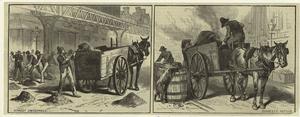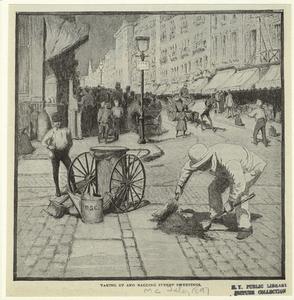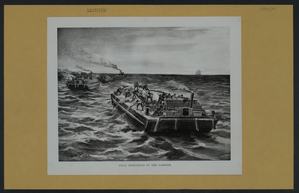What did the residents of 97 Orchard Street do with their garbage?
 |
| Ludlow and Houston Streets. Photo: VNY |
To most of us living in the United States today, the filth of 19th century New York City is almost unimaginable. The ordinary conditions of urban life included accumulating piles of manure, rubbish, slops and waste dumped directly into the street. Filth and garbage, and the consequent odors, created a social dividing line between the relatively clean, respectable classes and the stinking, dank tenements and dirty bodies of the immigrant poor.
 |
| Cleaning up the streets, 1884. Photo NYPL. |
Throughout the 19th century, health agencies and reformers were sporadically moved to action by the threat of great epidemics. These sudden, catastrophic events compelled even politicians and businessmen to make sanitary improvements to the urban environment. A central historical and political debate throughout the 19th century was whether garbage collection and street cleaning were best left to private enterprise, with city contracts let to private companies, or whether they should be viewed as a public responsibility, under public control and employing municipal workers.
Before 1872, responsibility for street cleaning and waste collection was assumed by a succession of public and private ventures. Political ties figured strongly in the awarding of contracts to carting operations, and the city often took over for contractors who performed inadequately. Waste collection and street cleaning were handled by the Metropolitan Board of Police from 1872 until the Department of Street Cleaning was formed in 1881. Political patronage and corruption, however, remained an obstacle to effective service until 1895, when George Waring Jr. was appointed commissioner. He reorganized the department along military lines, minimized political influence in employing workers, stressed sweeping by hand rather than with machines, and dressed street sweepers in white duck uniforms, earning them the nickname “whitewings.”
 |
| "White Wings" at work, July 1897. Photo NYPL. |
 |
| Trash barges head to the ocean, 1899. Photo NYPL. |
After World War I, however, recycling efforts collapsed and the city returned to large-scale ocean dumping —- by the early 1930s, the city was throwing more than 2 million cubic yards of waste overboard each year. In 1934, the U.S. Supreme Court banned the practice.

No comments:
Post a Comment
Note: Only a member of this blog may post a comment.